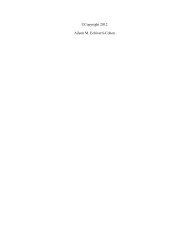Review of the TFW Monitoring Program.pdf
Review of the TFW Monitoring Program.pdf
Review of the TFW Monitoring Program.pdf
You also want an ePaper? Increase the reach of your titles
YUMPU automatically turns print PDFs into web optimized ePapers that Google loves.
mass wasting over unmanaged rates.<br />
Using <strong>the</strong> metric (acres/event/year) is more difficult than #/year and does not obviously provide<br />
more valuable information.<br />
Sediment delivery is extremely difficult to obtain and is not available as baseline condition for<br />
most watersheds.<br />
<strong>Monitoring</strong> and Evaluation:<br />
In this section <strong>the</strong>re seems to be ambiguity as to whe<strong>the</strong>r we are looking for convergence with<br />
"natural" rates, or just improvement from some previous value. That may be an unavoidable<br />
consequence <strong>of</strong> attempting to address multiple hypo<strong>the</strong>ses simultaneously. We believe <strong>the</strong><br />
emphasis should be placed on comparison to natural conditions. "Trends in natural and<br />
management induced mass wasting will be evaluated in <strong>the</strong> context <strong>of</strong> storm event magnitude<br />
and frequency" implies that <strong>the</strong>re will be unharvested (natural) watersheds to serve as controls.<br />
That seems unlikely and those watersheds will not be comparable to managed watersheds. For<br />
example, we cannot determine <strong>the</strong> effect <strong>of</strong> a particular cutting practice by comparing it to a<br />
natural watershed that does not have roads.<br />
Use <strong>of</strong> existing WA mass wasting inventories as <strong>the</strong> "baseline for past forest practices" is not<br />
consistent with <strong>the</strong> stated goal <strong>of</strong> using some measure <strong>of</strong> deviation from natural background<br />
rates as a metric for evaluating forest management performance. Past WSA are variable in<br />
quality. It is not valid to assume that <strong>the</strong>y will provide reliable information on past forest<br />
practices. More importantly, using past rates as a benchmark essentially defines poor<br />
management practices <strong>of</strong> <strong>the</strong> past as <strong>the</strong> acceptable standard <strong>of</strong> <strong>the</strong> future.<br />
It is frequently unclear what time frame is represented by an initial inventory. If we conduct<br />
inventory at regular intervals and accurately record and compare events, we can calculate rates<br />
<strong>of</strong> mass wasting events between sampling times. However, <strong>the</strong> initial survey will represent a<br />
longer and unknown time interval. Thus, it will provide an inflated value for baseline conditions.<br />
This baseline will represent past forest practices but not natural conditions. Five years is not an<br />
appropriate time frame to evaluate changes in <strong>the</strong> frequency <strong>of</strong> mass wasting events. Sampling at<br />
five year intervals will be confounded by past forest practices. Since mass wasting events tend to<br />
peak 10-15 years after harvest, it may be difficult to define <strong>the</strong> time period being evaluated.<br />
Because <strong>of</strong> <strong>the</strong> lag between harvest and slides it will take a long time to evaluate effects <strong>of</strong> past<br />
practices, and we may be attempting to evaluate different practices with <strong>the</strong> same data points.<br />
University <strong>of</strong> Washington Water Center 10
















